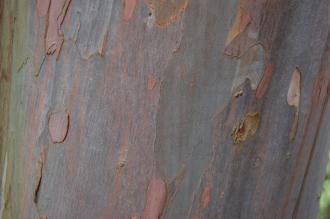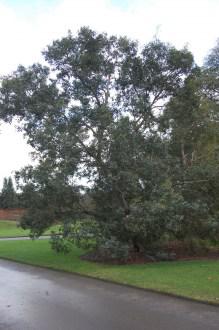
Eucalyptus nitida bark (21/01/2012, Kew, London)
Position: Full sun
Flowering period: Spring to summer
Soil: Moist, well drained
Eventual Height: 18m
Eventual Spread: 12m
Hardiness: 8a – 11
Family: Myrtaceae
Eucalyptus nitida is a fast growing, spreading, fine leaved evergreen tree. Its glossy narrow leaves are grey/ blue, aromatic (smelling of peppermint) with entire margins and are up to 13cm long and 2cm wide. The mature bark of this tree is smooth and grey/ pink, the young branch growth is green. The petalless flowers of the plant are white in colour, composed of many showy, usually white or creamy yellow.

Eucalyptus nitida (21/01/2012, Kew, London)
Eucalyptus nitida, commonly known as the Smithton Peppermint, Shining Peppermint or Smithton Peppermint Gum, is native to eastern Australia including Tasmania. It was first described by Joseph Dalton Hooker in 1856. E. nitida is synonymous with Eucalyptus simmondsii.
The etymological root of the binomial name Eucalyptus is derived from the Greek eu ‘good‘ and kalyptos ’covered’ referring to the calyx which forms a lid over the flowers when in bud. Nitida is from the Latin meaning ‘shiny’, referring to the foliage.
The landscape architect may find Eucalyptus nitida useful as a medium sized grey/ green specimen tree. It is drought tolerant once established.

Eucalyptus nitida leaf (21/01/2012, Kew, London)
Ecologically, E. nitidaum is of little value for wildlife in the UK.
E. nitida prefers moist, well-drained soils. It tolerates most pH of soil, although it prefers slightly acidic soils. It will tolerate poor soils.
E. nitida requires little maintenance.
Advertisement
